In early April of 1968, Baltimore was on fire literally and figuratively. The Reverend Dr. Martin Luther King, Jr. had just been assassinated. Profound sadness, anger, and disgust at the violent death of a man who championed social change exclusively through non-violent civil disobedience led to riots breaking out in many American cities – Chicago, Los Angeles, and Baltimore to name a few. In late April of 2015, America’s largest independent city is once again on fire. Before the eyes of the nation and the world, Baltimore is burning.
History is prologue. Years/decades of mutual mistrust between black citizens of and the police force of America’s 8th poorest city have erupted. Again.
Before I continue, let me speak plainly. Arson is asinine. Looting is ludicrous. Civil disobedience as a subterfuge for criminality is disgraceful – and an affront to Dr. King, Mahatma Gandhi, and anyone/everyone else bold enough to risk their lives to right a societal wrong. There’s nothing honorable about burning down your own neighborhoods. There’s not one molecule of nobility in damaging and looting the corner deli or mom-and-pop convenience store. There’s nothing redeeming about teenagers throwing cinder blocks, bricks, bottles, rocks, or anything else at police officers who are out there in harm’s way to protect and serve. Those things aren’t ever right; they’re wrong. In a joint press conference Tuesday with Japanese Prime Minister Shinzo Abe, President Obama said of looters in Baltimore: “They’re not protesting, they’re not making a statement, they’re stealing. They’re destroying and undermining businesses and opportunities in their own communities that rob jobs and opportunity from people in that area.”
The catalyst for Baltimore’s siege perilous is the death of Freddie Gray. On the morning of April 12th, members of the Baltimore Police Department encountered Gray. Gray ran from the police. After pursuing Gray on foot and on police bikes, police apprehended Gray and arrested him. That’s standard procedure. However, while he was in police custody, Gray sustained grievous injuries. When all was said and done, Gray’s neck was broken. His spinal column was almost completely severed. It has already been admitted by Baltimore Police Department that Gray was denied medical treatment by the officers present on several occasions that day. At least two different cellphone videos taken of Gray’s encounter with the police officers raise serious questions. There is a gap of one hour between the time Gray was arrested and the time an ambulance was called for him. There is no police video of that hour. That hour could easily have meant the difference between life and death for Freddie Gray. Gray lapsed into a coma and died a week later at a Baltimore hospital. I’m not a doctor, but even I know that the last thing you want to do is to move someone you even suspect has a broken back or a broken neck. That isn’t standard procedure.
A “rough ride” also isn’t standard operating procedure. A rough rides in police custody was the topic of an illuminating April 27th article in “The Atlantic” written by David A. Graham. Graham wrote: “A rough ride. Bringing them up front. A screen test. A cowboy ride. A nickel ride. Police say that intentionally banging a suspect around in the back of a van isn’t common practice. But the range of slang terms to describe the practice suggests it’s more common that anyone would hope – and a roster of cases show that Freddie Gray is hardly the first person whose serious injuries allegedly occurred while in police transit. Citizens have accused police of using aggressive driving to rough suspects up for decades in jurisdictions across the country. Though experts don’t think it’s a widespread practice, rough rides have injured many people, frayed relationships, and cost taxpayers, including Baltimore’s, millions of dollars in damages.”
Gray was laid to rest on April 27th in Baltimore, 8 days after his death. Things in the city began getting out of hand just after the conclusion of Gray’s funeral.
As fires rage through East Baltimore and West Baltimore, as episodes of looting sporadically occur, and while at least 15 Baltimore police officers lie in hospital beds with various injuries, Baltimore Mayor Stephanie Rawlings Blake said emphatically on Monday that it’s idiotic for Baltimore residents to destroy their own city and their own neighborhoods. She’s right, of course. Wanton destruction of property won’t bring Freddie Gray back to life. Looting will never bring forth justice for him.
There are numerous ongoing investigations into Gray’s death. Meanwhile, Maryland Governor Larry Hogan has declared a state of emergency for the city. The Maryland National Guard has been mobilized. Up to 5,000 additional police officers have been requested by Baltimore’s leaders from other urban cities and state agencies throughout the Mid-Atlantic region. City schools have been closed. Daytime and nighttime curfews have been imposed. Order will be restored, but the true question is when?
In 1827, President John Quincy Adams christened Baltimore as the “Monumental City.” For many years, Baltimore has been termed the “city of neighborhoods.” More recently, a 1970’s era advertising campaign branded Baltimore as the “Charm City.” Whichever moniker you prefer, the city which produced Edgar Allen Poe has one more unwanted subtitle: city on fire. Baltimore’s burning, folks – in more ways than one. Lots of prayer – and patience – is needed.

